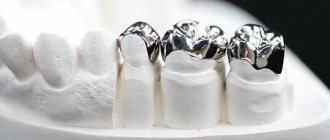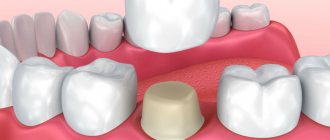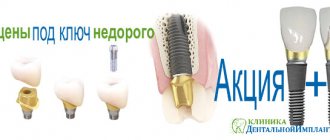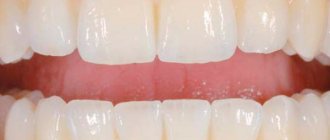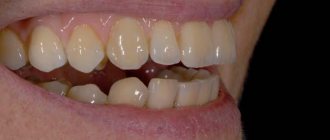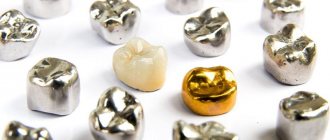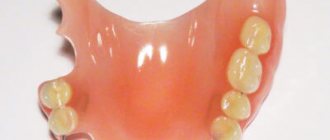- Indications for the use of a core inlay made of zirconium dioxide
- Contraindications
- Materials for the manufacture of stump inlays
- Inlays for chewing and front teeth
- Pros and cons of stump inlays
- Stump tab or pin?
- Manufacturing process
- Single-channel and multi-channel tabs
A zirconium dioxide inlay is one of the many methods in modern dentistry that is used to restore damaged teeth. When wanting to restore a dental unit damaged by caries or trauma, many patients encounter a number of difficulties that prevent them from using one or another method. A variety of techniques - provide variability, but do not exclude the presence of shortcomings in each of them. Each clinical case is individual.
The zirconium stump inlay consists of several parts. The first is immersed in the root, the other is located on the surface and serves as the main one, onto which a crown is installed using special cement. In cases where most of the tooth is destroyed - 2/3 or about 50-70%, this method of restoration is the most effective and safe.
Indications for the use of a core inlay made of zirconium dioxide
The main indications for using the method are the following factors:
- The need to install a “bridge”
- The need to strengthen the dental unit on which a crown is required,
- 2/3 of a tooth or more is destroyed.
In cases where the patient requires, for example, the installation of a bridge, but the dental units on which it is planned to be attached are severely damaged, the dentist may suggest the use of stump inlays. However, it is worth considering that, like other techniques, this one has some contraindications, in which the use of the technology is not recommended or completely contraindicated.
What is known about the shortcomings
According to reviews from some patients, a zirconium inlay (restorative or stump) has only one drawback - its high cost. Another disadvantage is the time spent on prosthetics - it takes about 2 weeks to complete the treatment. Although, for example, CEREC technology allows you to make a restorative microprosthesis in 15-20 minutes - and it will be installed on the day you go to the clinic. However, such equipment is not available everywhere.
Read on the topic: what is CEREC technology - when does the dentist and patient need it, its pros and cons.
Another disadvantage is the pure white color of zirconium dioxide (several shades lighter than natural enamel) and its opacity. But dental technicians solve this problem by applying liquid ceramic, colored in the shade of enamel, to the upper part of the zirconium restorative microprosthesis. Or you can use alternative prosthetic options (more on them below).
Contraindications
Among those contraindications in which the attending physician will not recommend the use of stump placements or will postpone the procedure include:
- The presence of inflammatory processes in the oral cavity in the root area or in the area of installation of the planned crown.
- The tooth was not treated.
- Advanced stages of periodontitis.
- The zirconium dioxide inlay is hypoallergenic. However, in cases of using other materials (for example, metal tabs), the presence of allergies is another contraindication.
Service life and care features
The service life of zirconium dioxide is very long - 15, 20 and even 25 years. Such long-term operation will depend both on the quality of preparation of the tooth for prosthetics and the accuracy of the fit of the orthopedic structure, as well as on compliance with the rules of wearing and caring for prostheses. What is needed for this? Do not forget about regular brushing of your teeth in the morning and evening, avoid hard and stretchy products (so that the denture does not come off). Ideally, you should also visit your podiatrist twice a year for a checkup.
Materials for the manufacture of stump inlays
Various materials are used for manufacturing; the choice in favor of one or the other depends on a number of reasons:
- From the position of the tooth in the oral cavity. For example, metal inlays cannot be used to reconstruct the front teeth (in the smile area), since they are very noticeable and will stand out from under the crown.
- Patient's financial capabilities.
- Allergic reactions. Materials are classified as hypoallergenic or not. Metal inlays may cause allergies in the patient, but are much more durable. Ceramic inlays, on the contrary, are much safer for patients with allergies, but may not withstand mechanical stress.
In connection with the above, the best option for most patients is the use of metal-ceramic inlays. They also have sufficient strength, which is why the risk of breaking them is significantly lower, aesthetic appeal - it is almost impossible to visually distinguish such inlays from natural teeth, and will not cause an allergic reaction in patients with hypersensitivity.
The metal-ceramic inlay contains zirconium dioxide. The service life of such a tab is up to 10 years. Installation is carried out in 2 stages, which is also a significant advantage of this procedure. In addition, the material does not change its shade during use, which means the teeth will not lose their aesthetic appeal years after installation.
According to many experts, one of the best options when choosing a metal/alloy for stump inlays is gold. Moreover, this is not at all the 585 alloy from which rings and earrings are made. In this case we are talking about 750 sample and above, with the addition of 10% platinum. This makes it possible to process the material much more accurately, resulting in an excellent edge seal. Silver and silver-palladium alloys are also used. The gold tab will last 15 years or more.
Among the inexpensive metal options, chrome-cobalt and chrome-nickel alloys, titanium and surgical steel are popular.
On the one hand, doctors recommend silver-based materials, because it has bactericidal properties. On the other hand, it has one drawback, which is expressed in the staining of the gums. The pigmentation is noticeable enough to cause concern and dissatisfaction among patients.
The alloy with nickel shrinks and is harmful to health. Cobalt-chrome is better, but more difficult to process. Titanium is more convenient in this regard, but in some cases it turns out to be too fragile. After all, more massive products are usually made from it.
The simplest and cheapest is the composite tab. Essentially, this is the same photopolymer filling, the only difference being that it is formed not directly in your tooth, but in advance, in a dental laboratory. The disadvantages are the same - low strength and durability. If it falls out, then there is usually no warranty with a free replacement. And it can fall out quite quickly. Statistics show that for many people, such a tab falls out within a year or two. That is, there is no point in installing it. Composites are used for restorative inlays. Photopolymer materials are not suitable at all for stump inlays.
Inlays for chewing and front teeth
If you need to restore a molar that is 50-70% destroyed and does not fall into the smile zone, there is no point in spending money on expensive metal-free products. It is much easier to use CHS (cobalt-chromium alloy). It costs much less, is durable and reliable. The only option when it is not suitable is an allergy to metal.
If you are going to put a crown on a front tooth, any metal will show through. In this case, the optimal solution is zirconium dioxide. If they try to persuade you to get a crown with a fiberglass post, don't agree. The strength of this design is questionable. There is a high probability that you will forget about the maximum load and simply break a tooth.
General information about designs
Zirconium dioxide inlay - what is it? You need to understand that inlays in dentistry belong to the field of prosthetics, or more precisely, microprosthetics. That is, these are small-sized prostheses, which come in 2 types:
- restorative (or coronal): independently restore the integrity of the tooth,
- stump (or pin): serve as a support for another prosthesis - a crown, bridge, removable orthopedic structure.
Both restorative and pin inlays are made from zirconium oxide1 - we will describe below what each of these zirconium inlays is and what it looks like. It is worth noting that zirconium dioxide is a very strong material in compression and bending (more than 1400 MPa), in this it can even be compared with metal alloys. However, zirconium dioxide is more often called ceramics - more precisely, metal-free ceramics, since purely externally the material is white, like your own teeth.
%akc72%
Pros and cons of stump inlays
This method has many advantages. For example, the tab is fixed inside the canal much better than pins. The load on the teeth (especially chewing teeth) is uniform and natural. If you damage the crown, the inlay does not need to be replaced. They will simply make a new crown for you based on an existing impression.
Tabs are a universal solution. They can be used in cases of complex shape and obstruction of root canals. The product is cast, i.e. the crown and root parts will not split in half, and the upper part will not fall out. Disadvantages include prices and timing. Although the second point is controversial. Two visits within a week is, of course, longer than a one-time placement of a filling, but much faster than six months of suffering during implantation. Also, some people believe that to install such a tab, too much dentin has to be removed. But we all understand perfectly well that it is installed when there is significant destruction of the tooth crown, when other methods are not effective.
Are there any complications? Theoretically possible if the tab was placed in a tooth that was not pulpless. Its secondary caries and pulpitis are possible. Sometimes patients complain that their tooth hurts. If such symptoms occur, you should immediately consult a doctor for help. You may need to take a photo to determine what is causing your symptoms.
Cost of prosthetics in Moscow and other cities
How much does a zirconium inlay cost? Its price is 18-20 thousand rubles. Moreover, prices in the capital and other cities are approximately equivalent, because the basis is the cost of the material (which is purchased from the same manufacturers or suppliers).
1Zinovenko O.G., Shinkevich M.V., Sadovskaya I.V. Aesthetic prosthetics using zirconium dioxide, 2014.
Author: Sambuev B. S. (Thank you for your help in writing the article and the information provided)
Stump tab or pin?
Why do people often get pins immediately, without even being offered the option of making an inlay? It’s surprising, the average person might think, because the tab is more expensive and the doctor could earn more. The only problem is that many dentists believe that it is better to see many patients and put pins on them than to bother with each one for longer, and even in two appointments. Companies that make pre-fabricated pins also do their best to promote the idea that their products are the answer to everything.
Orthopedic dentists are very familiar with the statistics on the use of post restorations. They know that the service life rarely exceeds 3 years. Why do they continue to make a mistake, knowing about it? Because no warranty on a pin seal exceeds its service life. They have nothing to fear. The warranty period has expired, and then it’s not their problem anymore. Then people come to their colleagues whose teeth, restored in this way, simply fell apart. Everything would be fine if we were talking about single teeth, but often these are impressive bridges that have lost one of their important supports.
Manufacturing process
The procedure is quite complex and is carried out in several stages. First you need to prepare the tooth itself. Excess tissue is removed from it. Then, if required, each channel is processed to achieve parallel processing. The prepared surfaces are treated with Vaseline. Now liquid plastic is poured into the tooth for modeling. After this, special ashless pins are installed in each channel.
Next, the tooth is limited using a matrix so that plastic can be added in height. Now the model freezes, it is removed and checked for defects. If there are none or it is possible to eliminate them, the cast is brought to perfection. During this time, a temporary filling is placed in the tooth. The impression is sent to a dental laboratory, where an inlay is made from it.
Inlays are installed using direct and indirect methods. Direct is the simplest. The doctor makes an impression and then an inlay is made. In indirect, the patient’s bite is taken into account, so an impression is made of both jaws. It's more expensive, but more reliable. It is also possible to use computer technology. Specialists create a 3D model of the jaws to calculate how comfortable it will be for the patient. After all, an error of a few tenths or even hundredths of a millimeter significantly affects the bite.
Dental crowns
If we are talking about crowns, this is a fairly voluminous restoration. Dental crowns are used to restore the anatomical shape of the tooth, chewing and speech functions, and create a beautiful aesthetic effect. A crown may be a necessary measure if the tooth’s nerve has been removed and a large amount of tissue is missing. It can also be installed on a living tooth to restore the original shape of the tooth and, as a result, the correct bite: the height of the tooth, the shape of the tubercles, the area of the chewing surface directly affect the bite and the health of the teeth in the future.
Types of dental crowns
Single-channel and multi-channel tabs
If the tooth is multi-rooted, then the question arises: should I make a solid core inlay or a collapsible one? If the channels run parallel, solid blanks can be used. It is possible to determine how to proceed further only if the doctor has photographs of your tooth and sees how the canals pass. Some experts, in addition to standard diagnostic methods, recommend doing a CT scan. With the help of computed tomography you can see:
- condition of the root part;
- shape of root canals;
- the presence of periodontal and bone pathologies that require treatment. After all, you may have a cyst under your root that you didn't know about.
Overall, a multi-root stump is an excellent solution. Being held in several channels at once, it creates an even load on the entire tooth, is securely held and ensures that the root does not break. A crown based on such an inlay can be attached to a bridge without fear of damage or destruction.
Indications for installation
The installation of dental inlays is indicated in the following cases:
- fracture of the coronal part;
- carious destruction of the crown;
- anomalies in the location, shape or size of the tooth;
- low tooth crown;
- production of a bridge structure, when a pin stump inlay for a tooth is placed as a supporting element;
- need for splinting.
The strength of fixation, the quality of the structure and how long the product will last depend on the condition of the tooth root when a microprosthesis is installed into it. The root should not wobble, should be without curvature in the upper third, with passable, well-sealed canals and walls of sufficient thickness for prosthetics. The use of a stump structure is not recommended in the following cases:
- damaged circular ligament;
- resection of the root apex (temporary relative contraindication), as well as inflammatory processes in which the gums or peri-root tissues may hurt;
- poor hygiene;
- incomplete obturation of the canals;
- mobility 3 degrees.
In each clinical case, the decision on the advisability of installing a stump structure is made by the attending orthopedic surgeon together with related specialists, taking into account all the advantages and disadvantages of using this reconstruction. If there are relative (temporary) contraindications, before prosthetics, therapeutic treatment or surgical correction, as well as replacement of failed orthopedic structures, can be carried out.


